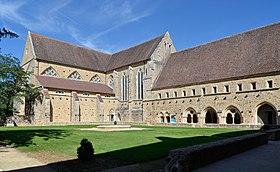Epoh Abbey ( fr. Abbaye de l'Épau ) is a Cistercian monastery in the French commune of Ivret-l'Evêque ( Sartis department, region of the Land of the Loire ). The Abbey was founded in 1229 by Queen Berengaria of Navarre , closed in 1790 during the Great French Revolution . Currently, a cultural center operates in the building of a former monastery. The abbey is located on the southeastern outskirts of the modern city of Le Mans , on the banks of the River .
| Monastery | |
| Epo | |
|---|---|
| Épau | |
 | |
| A country | |
| Department | Sarta |
| Denomination | Catholicism |
| Diocese | |
| Order of affiliation | Cistercians |
| Type of | male |
| Founder | Berengaria of Navarre |
| Founding date | 1229 |
| Date of abolition | 1790 |
| Status | Cultural Center |
| Site | epau.sarthe.com |
Content
History
Queen Berengaria of Navarre , the wife of the famous Richard the Lionheart , outlived her husband by more than 30 years. After the death of King Richard in 1199, she received from French King Philip Augustus possession of Le Mans with the surrounding lands, where she lived until her death. In 1229 she founded a Cistercian monastery near the city, called Epoch. In 1230, the first monks arrived at the new monastery, Sito , the main monastery of the order, became the mother abode for Epo. In the same year, Queen Berengaria died, which, according to her will, was buried in the monastery founded by her. The construction of the main buildings went from 1230 to 1280, separate buildings were erected until 1365. In 1234, the Bishop of Le Mans, Geoffroy de Laval, consecrated the monastery church in the name of the Most Holy Virgin Mary and St. John the Baptist [1] .
During the Hundred Years War in 1365, the inhabitants of Le Mans, fearing that the British would use the abbey as their rear fortress, set it on fire. The abbey was largely destroyed. Nevertheless, from 1366, for more than 40 years, gradual restoration work proceeded [1] .
In the 16th and 18th centuries, the right wing and the abbot's house were added to the abbey’s architectural complex.
By the beginning of the Great French Revolution, the abbey fell into decay, there were only a few monks left. In 1790 the monastery was closed, and later the abbey buildings were sold by auction and turned into a weaving workshop, then a farm [1] .
In 1924, the estate was acquired by the Guerrier family, who, with the support of the National High School of Fine Arts , carried out restoration work at Epoch. The works were interrupted by the Second World War, Epo occupied by the Germans, who turned it into military warehouses, garages and workshops [1] .
In 1958, the Sarta Department bought the abbey from private property, after which intensive restoration works started, mostly completed by 1971. Since that time, the abbey functions as a cultural center, there are concerts of classical music, conferences and exhibitions. Also in Epo there are meetings of the Assembly Department of Sart [1] .
Architecture
The monastery complex is a single complex of buildings surrounding the cloister on three sides. The complex includes [2] : the monastery church, abbot's house, cloister , chapel hall, scriptorium , kitchen, dormitory and other rooms. The whole complex is surrounded by a park of 13 hectares. In the chapel there is a tombstone of Berengaria of Navarre, it remains unknown whether the tombstone contains its remains. The queen died when the work on the construction of the monastery only started, and the sources do not say anything about the specific location of her grave. The tombstone in the course of history has moved many times, both in the monastery complex and in Le Mans. In 1988 it was placed in the chapters room [3] .
Notes
- ↑ 1 2 3 4 5 Abbey History
- ↑ Visitez l'Abbaye de l'Epau Neopr (Inaccessible link) . The date of circulation is November 16, 2016. Archived November 17, 2016.
- ↑ La Salle capitulaire (inaccessible link) . The date of circulation is November 16, 2016. Archived November 17, 2016.